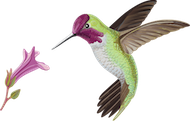As the Gottlieb Native Garden’s naturalist, Scott Logan documents the ever-changing array of wildlife species as they vary with the garden’s blooms, seasons and migratory patterns. While bringing these observations to life for all to experience, he also coordinates scientific research projects, and monitors the overall health and biodiversity of the garden. The Naturalist’s Journal also highlights the work the Gottliebs and Scott are doing to educate and inspire people to start gardening for wildlife with native plants.
Great Golden Digger Wasp
Wasps seem to be the busiest insects in the garden, in constant motion while searching for food for their young. Many species of wasps have long legs, allowing them to easily walk on foliage and swiftly run down prey. This great golden digger wasp was […]
Diversity of Native Bees
One of the greatest pleasures of having a native garden is watching native pollinators as they take advantage of the habitat you have created… Slevin’s cellophane bee – Colletes slevini Horsefly-like carpenter bee – Xylocopa tabaniformis orpifex mason bee – Dianthidium sp. Sweat bee – […]
Fortunate Spider, Unfortunate Honey Bee
Grass spiders are in the family Agelenidae, or funnel weavers. This family gets its name from the spider’s horizontal, sheet-like web that has a small funnel-like tube where the it can reside safely out of sight. Their webs are rather interesting because, for the most part, they […]
Number 25
This Fatal metalmark brings the GNG documented butterfly species count to twenty-five. Summer heat can bring beautiful things to your garden… Fatal metalmark – Calephelis nemesis ♂
Lacewing Larvae Defends Apache Plume
Green lacewings are welcome guests in the GNG as their larvae are ravenous predators of the eggs and immature stages of soft bodied insects, especially aphids. When left unchecked, many soft bodied insect species can become garden pests. Lacewings are one of the natural predators […]
Camouflaged?!?
We are quite certain that this grasshopper nymph could have picked a better spot to use its green camouflage coloring in a more effective way…
Evening Primrose Gets Pollinated
Leaf-cutter bees (Megachilidae) are productive pollinators for many flowering plants and like most of our native bees, are solitary. Even if not seen cutting or carrying leaves for their nest, leaf-cutters are easy to identify by the way they carry their pollen. A leaf-cutter bee’s pollen-carrying structure […]
Discarded Exoskeleton
If you look carefully, sometimes interesting clues can be found in your garden, clues left by animals passing through or living within. This empty exuvia (larval skin) was found at the upper pond and belonged to a dragonfly going through metamorphosis. We were very happy […]
Honey Bee on Buckwheat?
Nope! It is a syrphid fly, and this species happens to be an especially good bee mimic. And just as bees are good pollinators, so are many fly species. In fact, after bees, Syrphid flies are considered to be some of the best all-around […]
Oak Titmouse Grabs a Snack
In addition to the native foods the garden offers to birdlife, feeders are available for extra nutrition. Here an adolescent oak titmouse pulls a sunflower seed from a wire mesh feeder.

